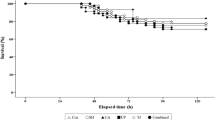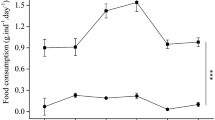Abstract
The suspension-feeding sea cucumber Cucumaria frondosa has become commercially important in recent years. Finding proper diets is the first important step for intensive aquaculture of this sea cucumber. In this study, adult C. frondosa were exposed to one of the following diet treatments: control (no diet provided), two powdered seaweeds (Ascophyllum nodosum and Saccharina latissima), a commercially available microalgal diet (shellfish diet) and natural seston. The effects of diets on the feeding behavior and physiological properties of sea cucumbers were investigated after a 5-week rearing period. Results show that sea cucumbers fed with shellfish diet exhibited a significantly higher tentacle insertion rate (1.80±0.20 insertion/min) than these fed with seaweed powders, and there was no significant different between the two groups fed by seaweed powders. No significant difference was found on the fecal production rate among the feeding groups. The minimum oxygen consumption rate was observed in the control group (5.76±0.99 μg O 2/(g·h)), which is significantly lower than individuals fed with A. nodosum, shellfish diet, and natural seston; however, no significant difference was shown between those of control and S. latissimi groups. The maximum ammonium excretion rate was found in the A. nodosum group (0.03±0.01 μmol/(g·h)), which is significantly higher than other groups. The minimum O/N ratio was observed in the A. nodosum group (14.57±1.04), which is significantly lower than the S. latissima, shellfish diet, and natural seston groups. Individuals fed with seaweed powders had similar physiological properties with these fed with microalgae diet and natural seston, indicating that A. nodosum and S. latissima can be explored as promising diets for intensive aquaculture of C. frondosa.
Similar content being viewed by others
Data Availability Statement
The datasets in the current study are not publicly available due to author request. It can be available from the corresponding author on reasonable request.
References
Al Shemaili J, Mensah-Brown E, Parekh K, Thomas S A, Attoub S, Hellman B, Nyberg F, Nyberg A, Collin P, Adrian T E. 2014. Frondoside A enhances the antiproliferative effects of gemcitabine in pancreatic cancer. European Journal of Cancer, 50 (7): 1 391–1 398.
Bruckner A W. 2005. The recent status of sea cucumber fisheries in the continental United States of America. SPC Beche-de-mer Information Bulletin, 22: 39–46.
Cranford P J, Armsworthy S L, Mikkelsen O A, Milligan T G. 2005. Food acquisition responses of the suspension-feeding bivalve Placopecten magellanicus to the flocculation and settlement of a phytoplankton bloom. Journal of Experimental Marine Biology and Ecology, 326 (2): (2–128.
Dong Y W, Dong S L, Tian X L, Wang F F, Zhang M Z. 2006. Effects of diel temperature fluctuations on growth, oxygen consumption and proximate body composition in the sea cucumber Apostichopus japonicus Selenka. Aquaculture, 255 (1–4): 514–521.
Eriksson H, Robinson G, Slater M J, Troell M. 2012. Sea cucumber aquaculture in the Western Indian Ocean: challenges for sustainable livelihood and stock improvement. Ambio, 41 (2): 2–109.
Gianasi B L, Parrish C C, Hamel J F, Mercier A. 2016. Influence of diet on growth, reproduction and lipid and fatty acid composition in the sea cucumber cucumaria frondosa. Aquaculture Research, 48 (7): 3 413–3 432.
Hamel J F, Conand C, Pawson D L, Mercier A. 2001. The sea cucumber Holothuria scabra (Holothuroidea: Echinodermata): Its biology and exploitation as Beche-de-mer. Advances in Marine Biology, 41: 129–223.
Hamel J F, Mercier A. 1996a. Early development, settlement, growth, and spatial distribution of the sea cucumber Cucumaria frondosa (Echinodermata: Holothuroidea). Canadian Journal of Fisheries and Aquatic Sciences, 53 (2): (2–253.
Hamel J F, Mercier A. 1996b. Gamete dispersion and fertilisation success of the sea cucumber Cucumaria frondosa SPC Beche-de-mer Information Bulletin, 8: 34–40.
Hamel J F, Mercier A. 1998. Diet and feeding behaviour of the sea cucumber Cucumaria frondosa in the St. Lawrence estuary, eastern Canada. Canadian Journal of Zoology, 76 (6): 1 194–1 198.
Hamel J F, Mercier A. 2008. Precautionary management of Cucumaria frondosa in Newfoundland and Labrador, Canada. In: Toral-Granda V, Lovatelli A, Vasconcellos M eds. Sea Cucumbers. A Global Review of Fisheries and Trade. FAO, Rome. p.293–306.
Holtz E H, MacDonald B A. 2009. Feeding behaviour of the sea cucumber Cucumaria frondosa (Echinodermata: Holothuroidea) in the laboratory and the field: relationships between tentacle insertion rate, flow speed, and ingestion. Marine Biology, 156 (7): 1 389–1 398.
Hu S W, Xu L L, Shi D, Wang J F, Wang Y M, Lou Q M, Xue C H. 2014. Eicosapentaenoic acid-enriched phosphatidylcholine isolated from Cucumaria frondosa exhibits anti-hyperglycemic effects via activating phosphoinositide 3-kinase/protein kinase B signal pathway. Journal of Bioscience and Bioengineering, 117 (4): (4–457.
Ikeda T. 1977. The effect of laboratory conditions on the extrapolation of experimental measurements to the ecology of marine zooplankton. I V. Changes in respiration and excretion rates of boreal zooplankton species maintained under fed and starved conditions. Marine Biology, 41 (3): (3–241.
King II T I. 1993. The effect of water temperature on hand volume during volumetric measurement using the water displacement method. Journal of Hand Therapy, 6 (3): (3–202.
Liu Y, Dong S L, Tian X L, Wang F, Gao Q F. 2009. Effects of dietary sea mud and yellow soil on growth and energy budget of the sea cucumber Apostichopus japonicus (Selenka). Aquaculture, 286 (3–4): 266–270.
Maxwell K H, Gardner J P A, Heath P L. 2009. The effect of diet on the energy budget of the brown sea cucumber, Stichopus mollis (Hutton). Journal of the World Aquaculture Society, 40 (2): 2–157.
Mayzaud P. 1976. Respiration and nitrogen excretion of zooplankton. I V. The influence of starvation on the metabolism and the biochemical composition of some species. Marine Biology, 37 (1): (1–47.
Nelson E J, MacDonald B A, Robinson S M C. 2012a. A review of the northern sea cucumber Cucumaria frondosa (Gunnerus. 1767). as a potential aquaculture species. Reviews in Fisheries Science, 20 (4): (4–212.
Nelson E J, MacDonald B A, Robinson S M C. 2012b. The absorption efficiency of the suspension-feeding sea cucumber, Cucumaria frondosa, and its potential as an extractive integrated multi-trophic aquaculture (IMTA) species. Aquaculture, 370–371: 19–25.
Otero-Villanueva M D M, Kelly M S, Burnell G. 2004. How diet influences energy partitioning in the regular echinoid Psammechinus miliaris; constructing an energy budget. Journal of Experimental Marine Biology and Ecology, 304 (2): (2–159.
Purcell S W, Samyn Y, Conand C. 2012. Commercially Important Sea Cucumbers of the World. FAO Species Catalogue for Fishery Purposes. No. 6. FAO, Rome.
Sabourin T D, Stickle W B. 1981. Effects of salinity on respiration and nitrogen excretion in two species of echinoderms. Marine Biology, 65 (1): (1–91.
Shi C S, Dong S L, Wang F, Gao Q F, Tian X L. 2013. Effects of four fresh microalgae in diet on growth and energy budget of juvenile sea cucumber Apostichopus japonicus (Selenka). Aquaculture, 416–417: 296–301.
Singh R, MacDonald B A, Lawton P, Thomas M L H. 1998. Feeding response of the dendrochirote sea cucumber Cucumaria frondosa (Echinodermata: Holothuroidea) to changing food concentrations in the laboratory. Canadian Journal of Zoology, 76 (10): 1 842–1 849.
Singh R, MacDonald B A, Lawton P, Thomas M L H. 2001. The reproductive biology of the dendrochirote sea cucumber Cucumaria frondosa (Echinodermata: Holothuriodea) using new quantitative methods. Invertebrate Reproduction & Development, 40 (2–3): 125–141.
Talbot T D, Lawrence J M. 2002. The effect of salinity on respiration, excretion, regeneration and production in Ophiophragmus filograneus (Echinodermata: Ophiuroidea). Journal of Experimental Marine Biology and Ecology, 275 (1): (1–1.
Taylor B W, Keep C F, Hall R O, Koch B J, Tronstad L M, Flecker A S, Ulseth A J. 2007. Improving the fluorometric ammonium method: matrix effects, background fluorescence, and standard additions. Journal of the North American Benthological Society, 26 (2): (2–167.
Therkildsen N O, Petersen C W. 2006. A review of the emerging fishery for the sea cucumber Cucumaria frondosa: Biology, policy, and future prospects. SPC Beche-de-mer Information Bulletin, 23: 16–25.
Uthicke S, Conand C. 2005. Local examples of beche-de-mer overfishing: An initial summary and request for information. SPC Beche-de-mer Information Bulletin, 21: 9–14.
Yang H S, Zhou Y, Zhang T, Yuan X T, Li X X, Liu Y, Zhang F S. 2006. Metabolic characteristics of sea cucumber Apostichopus japonicus (Selenka) during aestivation. Journal of Experimental Marine Biology and Ecology, 330 (2): (2–505.
Yu Z H, Qi Z H, Hu C Q, Liu W G, Huang H H. 2013. Effects of salinity on ingestion, oxygen consumption and ammonium excretion rates of the sea cucumber Holothuria leucospilota. Aquaculture Research, 44 (11): 1 760–1 767.
Yuan X T, Yang H S, Wang L L, Zhou Y, Zhang T, Liu Y. 2007. Effects of aestivation on the energy budget of sea cucumber Apostichopus japonicus (Selenka) (Echinodermata: Holothuroidea). Acta Ecologica Sinica, 27 (8): 3 155–3 161.
Yuan X T, Yang H S, Zhou Y, Mao Y Z, Zhang T, Liu Y. 2006. The influence of diets containing dried bivalve feces and/or powdered algae on growth and energy distribution in sea cucumber Apostichopus japonicus (Selenka) (Echinodermata: Holothuroidea). Aquaculture, 256 (1–4): 457–467.
Zamora L N, Jeffs A G. 2012. Feeding, metabolism and growth in response to temperature in juveniles of the Australasian sea cucumber, Australostichopus mollis Aquaculture, 358–359: 92–97.
Author information
Authors and Affiliations
Corresponding author
Additional information
Supported by the Natural Science and Engineering Research Council of Canada Network Program with the Canadian Integrated Multi-Trophic Aquaculture Network (CIMTAN), the Canada Department of Fisheries and Oceans St. Andrews Biological Station, the National Natural Science Foundation of China (No. 41676162), and the Science and Technology Service Network Initiative of Chinese Academy of Sciences (No. KFJ-STS-ZDTP-055)
Rights and permissions
About this article
Cite this article
Yu, Z., Robinson, S., MacDonald, B. et al. Effect of diets on the feeding behavior and physiological properties of suspension-feeding sea cucumber Cucumaria frondosa. J. Ocean. Limnol. 38, 883–893 (2020). https://doi.org/10.1007/s00343-019-9190-x
Received:
Accepted:
Published:
Issue Date:
DOI: https://doi.org/10.1007/s00343-019-9190-x




